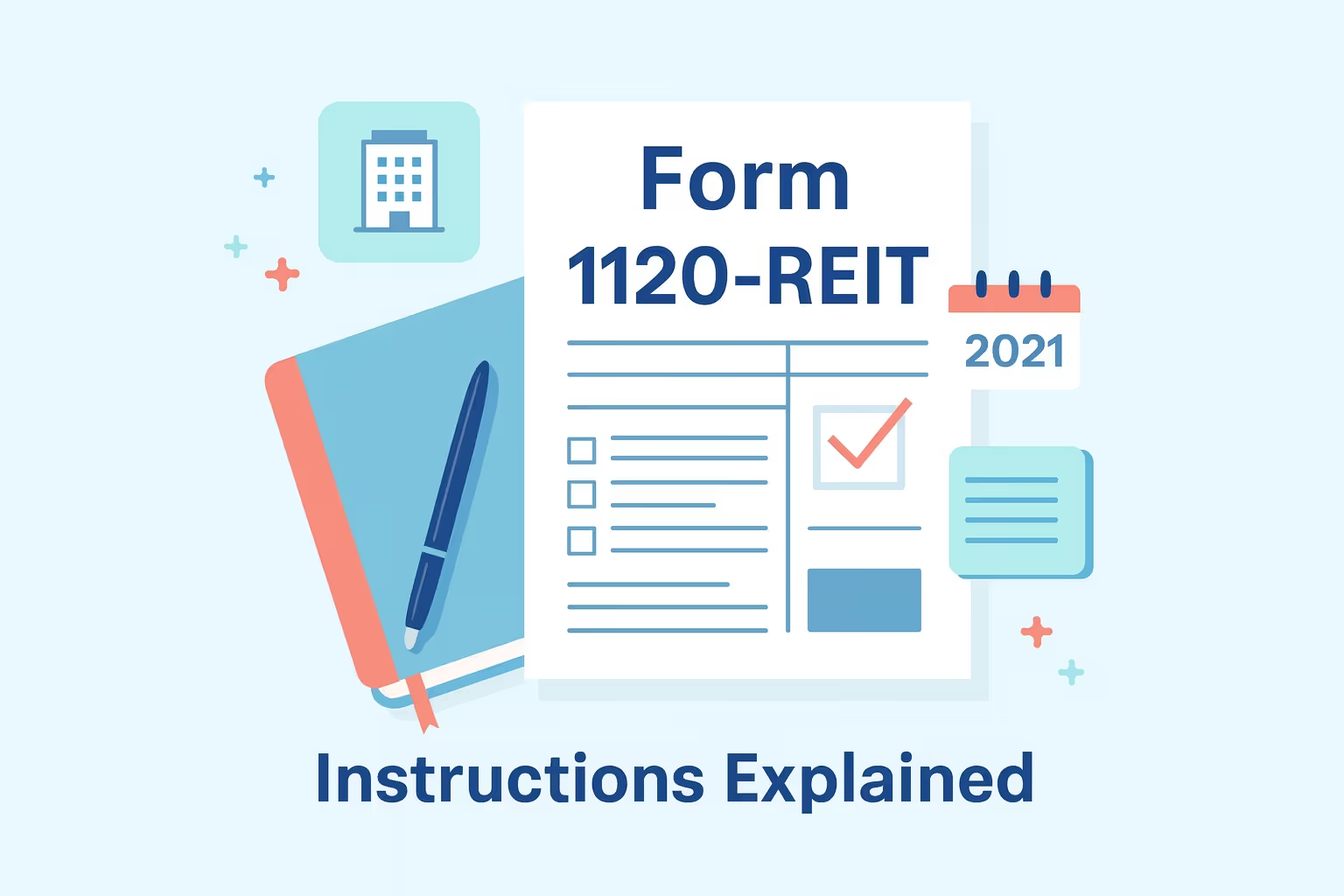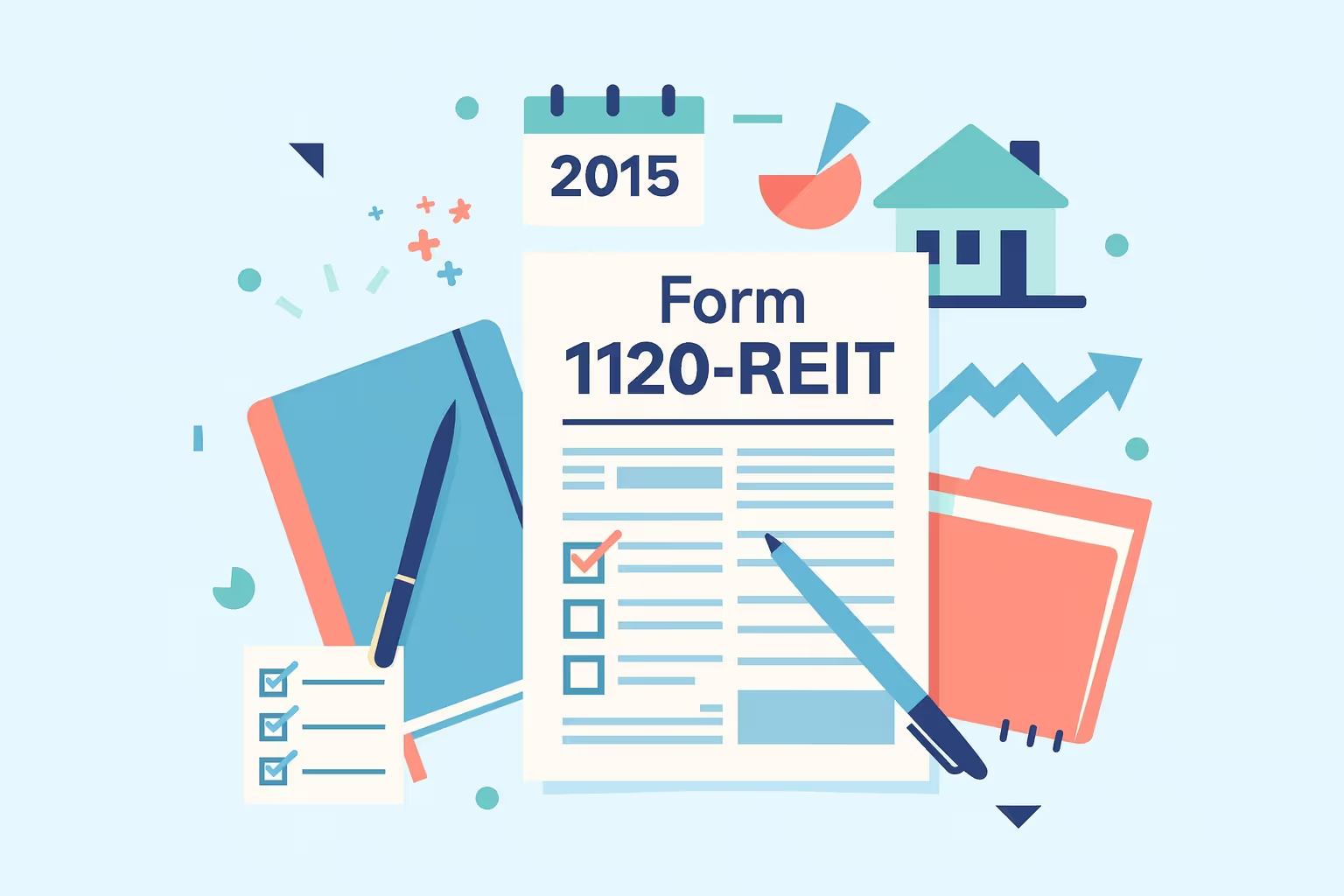Filing Guide: Form 1120-REIT 2021 Instructions Explained

Form 1120-REIT is the official income tax return that every real estate investment trust (REIT) must file with the Internal Revenue Service (IRS). This form reports the trust’s annual income, deductions, credits, and tax liability for the taxable year. It ensures that a REIT accurately documents its earnings, distributions, and compliance with federal tax laws that govern real estate investment entities.
Filing Form 1120-REIT correctly is essential for maintaining REIT status and avoiding penalties. The IRS requires this filing from corporations, trusts, or associations elected to be treated as REITs under federal law. Mistakes such as misreporting taxable income, missing schedules, or filing late can lead to financial penalties or even loss of REIT qualification, which affects dividends, shareholder returns, and ongoing tax benefits.
This filing guide explains the instructions for Form 1120-REIT 2021 in plain language. It walks through each part of the form—from reporting income and deductions to attaching the required schedules—so you can confidently file. Whether you manage a large REIT or are filing for the first time, this article provides a step-by-step overview to help you stay compliant and meet IRS requirements efficiently.
What Is Form 1120-REIT?
Form 1120-REIT is the U.S. income tax return that every real estate investment trust (REIT) must file each taxable year. It reports the REIT’s gross income, deductions, profits, losses, and taxes owed to the IRS. The form ensures that a REIT’s taxable income is calculated correctly and qualifies for the deductions and distributions required to maintain its special tax status.
This form plays a critical role in REIT tax filing because it verifies that the trust complies with the rules established under the Internal Revenue Code. These rules determine how much of a REIT’s income must come from real estate assets, rents, mortgages, and other qualifying investments. Filing this return accurately helps prevent penalties and preserves REIT election status.
According to the official IRS Form 1120-REIT instructions, each filing also states that the trust has distributed the required percentage of its income to shareholders, reported dividends correctly, and met the income and asset tests outlined in Section 856 of the tax code.
Who Must File Form 1120-REIT
- Corporations, trusts, or associations that elect to be treated as a REIT must file this form for each taxable year.
- A REIT that has previously elected this status must continue filing Form 1120-REIT until the election is terminated or revoked.
- Filing is mandatory even if the REIT has no taxable income or activity during the year, as doing so preserves its election and compliance standing.
By correctly submitting Form 1120-REIT 2021 instructions, each entity complies with federal tax law and secures its ability to operate as a qualified real estate investment trust.
Key Updates for the 2021 Tax Year
The 2021 tax year introduced several changes that REITs must account for when completing Form 1120-REIT 2021 instructions. These updates reflect both COVID-19 relief measures and evolving IRS electronic filing requirements.
COVID-19 Relief and Wage Credits
- The American Rescue Plan Act (ARP) extended credits for qualified sick and family leave wages, allowing certain wages to be claimed on a REIT return.
- The Employee Retention Credit (ERC), initially established under the CARES Act, was limited to qualified wages paid before October 1, 2021 (or January 1, 2022, for recovery startup businesses). Some eligible REITs could incorporate this credit in their Form 1120-REIT filings.
Continued Electronic Deposit Mandate
REITs must use electronic funds transfer to pay all federal tax deposits, including estimated taxes, corporate income tax payments, and employment taxes. Simply mailing checks is no longer permitted for federal tax obligations.
Impact on REIT Filers
These updates mean that REITs must:
- Confirm eligibility for ARP and ERC credits and report them appropriately on Form 1120-REIT.
- Ensure all federal tax payments are made via EFT (Electronic Funds Transfer).
- Review the 2021 Instructions (from the IRS Form 1120-REIT guide) to apply these rules correctly.
By factoring in these 2021-specific updates, your filing will align with IRS requirements for that year and reduce the risk of errors or disallowed claims.
Step-by-Step Instructions for Completing Form 1120-REIT
Use this walkthrough with the Form 1120-REIT 2021 instructions to complete each section accurately. The steps below organize the filing process in the order most filers follow, from preparation to attachments. Keep supporting records with the return to substantiate amounts and satisfy REIT qualification rules.
Before You Begin
- Gather financial statements, trial balances, and schedules that reconcile the book to tax so you can calculate gross income, deductions, and taxable income.
- Confirm the REIT’s Employer Identification Number (EIN), legal name, address, and formation date so the header matches IRS records.
- Assemble ownership records show beneficial ownership, outstanding stock, and five or fewer individuals did not own more than 50% during the last half of the taxable year.
- Compile income detail by category, including rents from real property, interest on mortgages and obligations secured by real property, gains, and any impermissible tenant service income.
- Prepare dividend documentation to support the deduction for dividends paid, including consent, spillover, or deficiency dividends if applicable.
- Collect information for subsidiaries, including any taxable or qualified REIT subsidiary activity affecting income, assets, or disclosures.
Step 1 — Complete the Header Information
- Enter the legal name, address, EIN, and the date the entity was organized so the IRS can identify the return.
- Check the appropriate boxes for the final return, name or address change, or amended return so the filing reflects the current status.
- State total assets at year-end to align with the balance sheet and to inform required schedules.
- Indicate the REIT type and any 100%-owned subsidiaries so the IRS understands the structure and reporting relationships.
- If using a fiscal year, clearly show the taxable year so that due dates and estimates are tied to the correct period.
Step 2 — Part I: REIT Taxable Income
- Report gross receipts and other income, including rents, interest, dividends, capital gains, and other items that comprise the REIT’s gross income. Provide statements when line descriptions require additional detail.
- Classify interest from mortgages and obligations secured by real property separately from other interest to track qualifying income for annual income tests.
- Include dividends from a taxable REIT subsidiary and note any amounts relating to services customarily furnished to tenants.
- Deduct allowable expenses such as depreciation, interest, taxes, and other ordinary and necessary costs to determine taxable income. Apply any limitations before claiming the amounts.
- Review activities that could create unrelated business taxable income for certain shareholders and document them in supporting statements.
- Compute taxable income before the dividends paid deduction and keep the worksheet with the return so that later sections can reconcile.
Step 3 — Schedule A: Deduction for Dividends Paid
- Calculate the deduction for dividends paid, including cash and property distributions that qualify under the rules. The calculation must reconcile the declared and paid dividends for the taxable year.
- Include consent dividends and spillover dividends that meet timing requirements so the deduction reflects amounts treated as paid for the year.
- Retain board resolutions, payment confirmations, and ownership ledgers to support the deduction and the 90% distribution requirement used elsewhere in compliance testing.
- If deficiency dividends apply, attach the required statements so the IRS can evaluate the adjustment.
Step 4 — Additional Parts (II–IV)
- Part II — Net Income From Foreclosure Property: Report and compute the tax on net income from foreclosure property that does not qualify under the 75% or 95% tests. Provide schedules that identify the property and income type.
- Part III — Failure to Meet Certain Source-of-Income Requirements: Use this part when the REIT does not meet the annual income tests but qualifies for the reasonable cause exception. Attach computations and explanations.
- Part IV — Net Income From Prohibited Transactions: Report dealer-type property sales and compute the tax on prohibited transactions. Include property lists and gain calculations to support the amounts reported.
Step 5 — Required Schedules and Attachments
- Attach capital gain and investment schedules, including Schedule D, so profits and losses can be reconciled to Part I and the balance sheet.
- Include Schedule N and other statements for international or intercompany items when required, so reporting is complete.
- Add forms that apply to REIT operations, such as Form 8612 (excise tax on undistributed income), Form 8996 (qualified opportunity fund), Form 8875 (taxable REIT subsidiary election), and any Forms 5471 or 8865 for foreign investments.
- Provide dividend reporting (for example, Form 1099-DIV summaries) and asset tests that show real estate, government securities, and personal property ratios.
- Follow the standard attachment order and label statements clearly so reviewers can trace totals to the return.
How to File Form 1120-REIT (Paper and Electronic Options)
Filing Form 1120-REIT accurately and on time is vital for compliance with IRS regulations. The form can be filed by mail or electronically, depending on the REIT’s assets, filing volume, and preference. Review the instructions for Form 1120-REIT 2021 to confirm the correct method for your situation.
Filing Addresses for Paper Returns
If you choose to file by mail, send your return to the IRS Service Center that corresponds with your principal business location.
- For REITs located in Connecticut, Delaware, Georgia, Illinois, Maryland, New York, Pennsylvania, and similar states:
Department of the Treasury
Internal Revenue Service
Kansas City, MO 64999-0012 - For REITs in all other states and foreign addresses:
Department of the Treasury
Internal Revenue Service
Ogden, UT 84201-0012
Different addresses may apply if your REIT has total assets of $10 million or more or files Schedule M-3.
Electronic Filing and Payment
REITs with assets of $10 million or more that file 250 or more returns annually must submit Form 1120-REIT electronically. E-filing is also encouraged for smaller entities because it speeds processing and reduces errors. All federal tax payments—including corporate income tax, excise tax, and estimated tax deposits—must be made electronically through the Electronic Federal Tax Payment System (EFTPS).
Payments should be scheduled by 8 p.m. Eastern the day before the due date. You may also authorize a payroll provider, financial institution, or third-party tax service to make payments on your behalf. Keeping confirmations from EFTPS or other electronic payment systems ensures proof of timely filing and payment compliance.
REIT Qualification and Compliance Requirements
Real estate investment trusts must meet structural and income standards yearly to keep REIT status. The rules below summarize how the qualification works and what to watch during filing and planning.
REIT Organizational and Income Tests
- Structure and eligibility: A REIT must be a domestic corporation, trust, or association managed by trustees or directors, have transferable shares, and not be a bank or insurer. It cannot be closely held under the 5/50 rule and must have 100 or more shareholders by the second taxable year. These are the core REIT qualification rules.
- 75% income test: At least 75% of gross income must come from real estate sources, such as rents from real property, interest on mortgages secured by real property, and gains from real property sales.
- 95% income test: At least 95% of gross income must come from the 75% categories plus dividends, interest, and other qualifying investment income. Document sources carefully to satisfy the REIT income tests.
- Cure provisions: If a test is missed for reasonable cause, a REIT may pay a penalty tax and retain its status. Keep computations and explanations with the return.
90% Distribution Requirement
- Annual payout: A REIT must distribute at least 90% of taxable income (excluding net capital gains) as dividends to shareholders. This supports the deduction for dividends paid and preserves REIT status. Use board minutes and payment records to prove amounts.
- Timing: Pay most dividends during the tax year. Inevitable spillover or deficiency dividends may count if statutory steps are met.
- Consequences: Missing the 90% distribution requirement can trigger additional taxes, reduce deductions, and risk loss of REIT status.
Excise Tax on Undistributed Income
- 4% excise tax: Under section 4981, a REIT may owe a REIT excise tax equal to 4% of the excess of the required distribution over actual distributions for the calendar year.
- Required distribution formula: Generally, it equals 85% of ordinary income, plus 95% of capital gain net income, plus 100% of prior-year undistributed amounts.
- How to avoid it: Monitor projected ordinary income and capital gains during the year, make catch-up distributions before December 31, and file Form 8612 if tax is due. Careful tracking reduces penalties and supports compliance.
Common Filing Mistakes and How to Avoid Them
Filing Form 1120-REIT requires careful attention to detail. Even experienced filers can make errors that lead to penalties, delayed processing, or potential loss of REIT status. The following points highlight common mistakes and how to prevent them.
Frequent Errors
- Incomplete or inaccurate entries: Leaving fields blank or entering “See attached” without details causes processing delays. Each item should be clearly completed to the extent required by the instructions.
- Incorrect ownership or structure reporting: Failing to confirm that a REIT is managed by one or more trustees or misreporting ownership can result in a rejected return. Always verify organizational data and the presence of transferable certificates to prove eligibility.
- Nonqualifying income or asset reporting: Misclassifying such income as rental or mortgage interest can cause test failures. Ensure that all loans secured by real property and related income sources are reported in the proper sections.
- Closely held status oversight: Not monitoring the 5/50 ownership rule during the last half of the taxable year can disqualify the REIT. Maintain shareholder records to confirm compliance.
- Errors in financial reporting: Misstating accumulated earnings or omitting dividend distributions affect taxable income calculations. Always reconcile retained earnings and dividends before filing.
- Incorrect form filing: Submitting the return under the wrong company classification—such as that of an insurance company—may trigger IRS correspondence. Confirm entity type before submission.
- Omitted schedules or attachments: Missing schedules for property, one issuer holdings, or income details can lead to penalties. Attach all required forms and statements.
Best Practice
Set aside sufficient time to review totals, confirm payment proofs, and ensure every dollar of money reported ties back to source documentation. Accuracy and organization remain the best defense against costly REIT filing issues.
Filing for Dormant or Zero-Activity REITs
Even if a real estate investment trust (REIT) has no income or operations during the year, it must still file Form 1120-REIT to preserve its election and remain compliant with IRS rules. Failure to file may subject the entity to standard corporate income tax treatment and potential penalties.
Filing Steps for an Inactive REIT
- Complete identifying details: Enter the REIT’s name, address, and Employer Identification Number exactly as shown on prior filings.
- Report zero activity: Enter “0” or “N/A” on income, deduction, and tax lines to confirm no business activity.
- Attach required schedules: Include supporting forms showing no transactions or holdings, even when activity is minimal.
- Maintain documentation: Keep statements for any indirectly owned real estate, securities, or investments, as the IRS may still request proof of ownership.
- Confirm mailing or e-filing: File by the regular due date to avoid penalties and maintain continuous election status.
A dormant REIT is not automatically exempt from filing. Submitting a complete, accurate return annually ensures uninterrupted recognition as a qualified REIT and avoids costly reinstatement procedures.
First-Time REIT Filers: Key Tips
Filing Form 1120-REIT for the first time can feel complex, especially for newly established real estate investment trusts. The following tips will help ensure your first filing meets IRS standards and sets a foundation for ongoing compliance.
Before Filing
- Verify eligibility: Confirm the entity meets REIT structure rules—organized as a corporation, trust, or association with transferable shares managed by trustees or directors.
- Meet shareholder requirements: The REIT must have at least 100 shareholders by the second taxable year and cannot be closely held by five or fewer individuals.
- Prepare accurate records: Maintain detailed documentation of assets, ownership, and income sources to support all entries on the return.
During and After Filing
- Adopt a calendar year: Most first-time filers must use a calendar year for tax reporting unless otherwise qualified.
- Distribute income: To qualify for REIT tax treatment, pay at least 90% of taxable income to shareholders as dividends.
- Use reasonable cause relief: If a requirement is missed, apply the REIT reasonable cause exception with an explanation and documentation.
Starting correctly helps new REITs maintain their election, avoid penalties, and establish sound reporting practices for future filings.
Professional Help and IRS Resources
Many entities benefit from professional guidance because Form 1120-REIT involves complex tax calculations and qualification tests. A certified public accountant (CPA) or tax advisor experienced in real estate investment trusts can help ensure that income tests, asset limits, and distribution requirements are met accurately. Professional assistance also reduces the risk of errors that could affect REIT status or trigger penalties.
When preparing your return, reference official IRS materials for current rules and form updates. The IRS Form 1120-REIT PDF and related instructions provide detailed filing procedures, examples, and clarifications for special situations such as foreclosure property, dividend deductions, or excise tax. Consulting experts and using verified IRS resources support complete, compliant filings and strengthen long-term REIT compliance practices.
Frequently Asked Questions (FAQs)
When is the income tax return for a REIT due?
A real estate investment trust (REIT) must file its income tax return by the 15th day of the fourth month after the end of its taxable year—usually April 15 for calendar-year filers. If the due date falls on a weekend or holiday, the deadline moves to the next business day. Filing on time preserves REIT election status and avoids late-payment penalties or interest assessed by the IRS.
Can a real estate investment trust request an extension to file?
Yes, a REIT can request an automatic six-month extension by filing Form 7004 on or before the original due date. However, this extension applies only to filing the return—not to paying tax owed. Any balance due must still be paid by the original deadline to prevent interest and late-payment penalties under IRS rules. Always retain confirmation of the timely extension filing.
What happens if a REIT misses the filing deadline?
Missing the filing deadline can lead to penalties of 5% of the unpaid monthly tax, up to 25%. Failure to file may also risk loss of the REIT election if errors or omissions remain uncorrected. Submitting the income tax return as soon as possible, along with payment and any missing schedules, reduces penalties and helps preserve compliance with IRS filing requirements.
Do REITs that own real estate but have no income still need to file?
Yes, even if a REIT owns real estate but earns no income, it must still file Form 1120-REIT each year. Filing a zero-activity return confirms the trust’s continued election and prevents automatic termination. Reporting “0” for income and deductions demonstrates compliance, while non-filing could result in loss of REIT status and reinstatement delays or additional IRS scrutiny.
How can a REIT amend a previously filed real estate investment return?
A REIT that discovers errors should file an amended Form 1120-REIT and check the “Amended return” box. The form should clearly explain corrections, revised schedules, and supporting documentation. Filing promptly prevents discrepancies across years and ensures the accuracy of the real estate investment records maintained by the REIT and the IRS, reducing the risk of follow-up notices or penalties.























